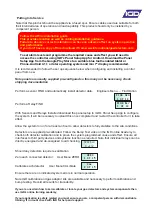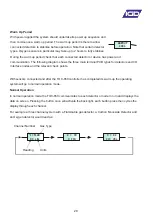
Putting into Service Test Schedule
In conclusion by following the steps discussed your checklist for putting into service should be:
2
3
4
1
9
6
8
7
10
11
5
Ensure the mains power supply is via a fused spur and installed in accordance with local
installation wiring regulations.
Check cable and glands are of suitable type for both the area of application and load carrying
capacity.
After warm up is complete use a suitable known calibration gas to check the detector calibration
reading. Adjust if necessary (see later “zero and calibration function” section).
Complete any site paperwork as necessary and instruct the site responsible person regarding
day to day operation (see later section “ user operation “).
Ensure terminations via glands provide a positive seal.IGD Gland packs PN TOC-GLAND
achieve minimum requirements when correctly installed
Download the controller setup and save as a backup for the system.
Bump Test to check programmed cause and effect operates as required
Check the shipping TOC-650 SET UP REPORT to check how the controller and interfacing
detectors and nodes have been configured. Ensure that the detector addresses match the
document and required site locations.
Leave all interfaces unplugged and check installation cabling terminations following IGD 2-Wire
Installers Guide, check website for latest revisions.
After warm up is complete use instrument air or Nitrogen as appropriate to check the detector
zero reading. Adjust if necessary (see later “zero and calibration function” section).
Power up the system. Check that all connected devices indicate that they have power and are
communicating correctly.
Allow at least 1 hour for the detectors to correctly warm up and stabilise.
During this period, if the relay outputs are being used check the cabling then plug in and test
using the TST RLY function.
In the event that the controller needs amendment to set up follow the instructions in the following
sections.
c) Assigning relay outputs
d) Zero and Calibration Function (detectors)
a) Adding detectors or nodes to the controller or complete set up
b) Adding or changing alarm levels
e) Zero and Calibration Function (analogue output)







































